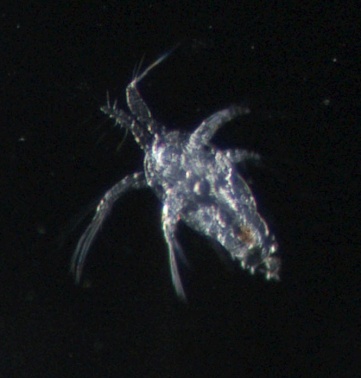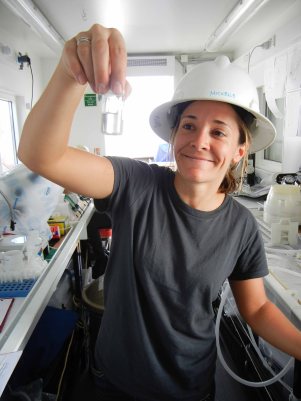My research is all about copepod nauplii. These are the early developmental stages of copepods, which can be extremely abundant in the water column because a single adult copepod can lay numerous eggs per day. This abundance means they could be important consumers of small algae in the ocean, or as prey for larger organisms like fish larvae or other invertebrate predators. 
But, because copepod nauplii are nearly impossible to identify to species under a microscope, and are small enough that they are at the boundary between being able to sample with whole seawater and having to concentrate larger volumes of water, they are a challenge to study, and thus we don’t know very much about them. One of my primary goals on this voyage is to use targeted sampling with a CTD Niskin rosette to look at whether nauplii are concentrated at particular features within the water column. A CTD Niskin rosette is a common oceanographic tool that allows us to see how physical and chemical parameters of the water column like seawater temperature, salinity, or pH vary with depth or location in the ocean, and holds a ring of sampling bottles that we can close at particular depths and bring to the surface to analyze. To date there has been little description of naupliar depth distributions in the open ocean, and very little is known regarding species-specific distribution patterns. I am targeting my sampling on several features of the upper water column. For example, I am sampling in the upper region of the water column that is well-mixed by wind stress on the surface ocean, called the “mixed layer”, and also at the “deep chlorophyll maximum”, or a layer that includes the highest chlorophyll concentrations in the water column (within phytoplankton cells). 
A second goal is to look at whether particular species or developmental stages of nauplii concentrate within these water column features using DNA barcoding methods to identify nauplii to species. In addition to the CTD samples, I am also collecting nauplii with a very fine mesh net, with a pore size of 0.06 mm in the upper 200 meters of the water column. These samples will allow me to have more nauplii to work with, to compare to my CTD collections (for nauplii) and to our sampling of the adult copepod populations (with a bongo net).

I am not into fish, but you made me interested in copepod naupli.
Looking forward to your next blog.
Kind regards,
LikeLike